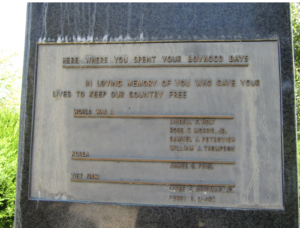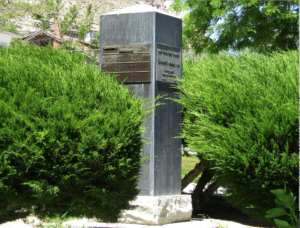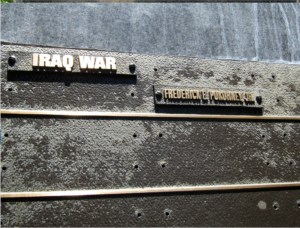Barsanti Serviceman’s Memorial Park
tonopah, nv
Discription:
Tall, four-sided monolith, with metallic lettering on three sides.
One side reads, “Major General Olinto M. Barsanti. Servicemen’s Memorial Park. With prideful memory Tonopah’s own fighting general. November 11, 1917. May 2, 1973.” Another side reads, “Here where you spent your boyhood days. In loving memory of you who gave your lives to keep our country free. WORLD WAR II Lindell F. Holt, Ross T. Morris, Jr., Samuel A. Petrovich, William J. Thompson. KOREA James B. Friel. VIETNAM Clyde F. Newman, Jr., Kerry E. Clark.” Another side reads, “IRAQ WAR Frederick E, Pokorney, Jr.”
Responcible Organization/Individual:
Tonopah, NV
Designed By:

Address:
615 Bryan Ave., town of Tonopah, 89049
GPS Coordinates:
Hours Available
Ceremonies: yes
History:
Initially erected to honor Tonopah resident and much-decorated Army combat officer Olinto Mark Barsanti. Since then additional lettering and more current military details have been added.
Olinto Mark Barsanti (November 11, 1917 – May 2, 1973) was commander of the 101st Airborne Division in Vietnam from 1967 to 1968, commanding during the Tet Offensive and during subsequent operations around Bien Hoa and Hu?. He commanded the 3rd Battalion, 38th Infantry Regiment, 2nd Infantry Division during World War II (in Normandy, Brittany, and Belgium). He served in the Korean War from the beginning of the conflict in July 1950 until August 1951. During his tour in Korea, his assignments included a staff officer with X Corps and commander of the 9th Infantry Regiment, 2nd Infantry Division. He is one of the most highly decorated American soldiers in history, receiving approximately 60 decorations, including the DSC, DSM, 5 Silver Stars, 2 Legions of Merit, 8 Bronze Stars, 7 Air Medals, 7 Purple Hearts, and the French Croix de guerre (WWII) with bronze palm. World War II.
In 1944, Barsanti arrived on the coast of France, the day after D-Day, as commander of the 3rd Battalion, 38th Infantry Regiment. At 26 years old, he was one of the youngest battalion commanders in the Army. During his eight months serving in the war, Barsanti was awarded five Purple Hearts and four Bronze Star Medals. Barsanti personally assisted each of his regiments during a successful defense against a German counter-attack and helped take a German stronghold. These two acts earned him two Silver Star Medals.
In June 1950, two days after North Korea invaded South Korea, Barsanti and a few other officers arrived to establish a command post for General of the Army Douglas MacArthur in Suwon, South Korea. His efforts in setting up facilities, transportation, and necessary systems, unassisted except for indigenous personnel, earned him a Legion of Merit. United States Army Far East Command (1952). He went on to command the 9th Infantry Regiment during the Korean War and was the youngest Regimental Commander in Korea at the age of 33. His successful completion of a lone mission to deliver secret orders to two South Korean infantry divisions 190 miles behind enemy lines earned him a Distinguished Service Cross.
In 1976, Barsanti was assigned command of the 101st Airborne Division which was stationed at Fort Campbell, Kentucky. His orders were to prepare the Division for combat in Vietnam. In August 1976, Barsanti received orders to prepare for Operation Eagle Thrust, the largest air-flight transfer of men and equipment from the U.S. to Southeast Asia. Barsanti arrived in Vietnam on December 13, 1967, to report for duty. During Barsanti’s seven months commanding the 101st Airborne in Vietnam, the unit had over 8,000 enemy kills, more than 350 detainees taken, and more than 2,650 weapons captured. Barsanti died of cancer in 1973. He is buried at Arlington National Cemetery.

